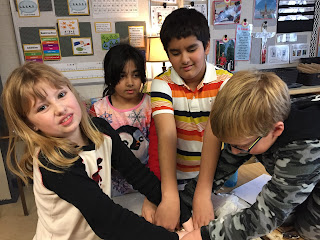Thursday, 17 December 2015
Saturday, 12 December 2015
I Am Canada Reader's Theatre
Saturday, 5 December 2015
Gastronomy Makerspace
We are chefs!
The students are creating treats for their parents for Christmas.
Looks delicious!
I loved the giggles and statements of, "I made it myself." The students felt a sense of pride and accomplishment.
We read to learn and procedural texts, such as recipes, show students that reading offers tangible results. Following step-by-step instructions to get to a finished result is an important reading skill, and using that skill to cook shows students that reading has very practical benefits.

The students are creating treats for their parents for Christmas.
Looks delicious!
I loved the giggles and statements of, "I made it myself." The students felt a sense of pride and accomplishment.
We read to learn and procedural texts, such as recipes, show students that reading offers tangible results. Following step-by-step instructions to get to a finished result is an important reading skill, and using that skill to cook shows students that reading has very practical benefits.
Monday, 30 November 2015
Canada
Thank you for educators around the world who express interest in our classroom and our studies.
We have been studying our nation- its land, its history, its symbols; and the location of Canada and its political regions. Our inquiry investigates how knowing our past influences our present.
To complement our study of Canada, we are studying historical fiction. Because historical fiction tends to start at a time of great historical tension, which almost inevitably means a time of change, readers who
pay attention to the feelings that a setting engenders will probably be
experiencing rising tension. In most historical fiction, the setting for the
story is a place that is in the throes of great pressures.
This unit, however, is not simply a unit on reading historical fiction. It is a unit on tackling complex texts. It is not simply to entice students to be swept up by the settings in their historical fiction novels. It is to help readers be more attentive to the tone and atmosphere in a setting and more alert to gathering tensions—to the winds of change.
Artifacts of learning and learning tasks will be posted soon!
Sunday, 15 November 2015
Monday, 9 November 2015
Remembrance Day
Thursday, 29 October 2015
Pumpkin Observation and Carving Day!
Tuesday, 27 October 2015
Rice Krispie Pumpkins
Mystery Fruit
Mrs. Funk had a mystery for the grade three students to solve. What is this unusual fruit?
We investigated our science books and looked at our charts.
We looked closely at the fruit - it was dark green and had a distinctive shape. The students noticed it looked like an acorn.
We researched acorn squash and found it looks like a winter squash and is a dark green. From the pictures, we knew this large squash was an acorn squash.
Great detective work!
We looked closely at the fruit - it was dark green and had a distinctive shape. The students noticed it looked like an acorn.
We researched acorn squash and found it looks like a winter squash and is a dark green. From the pictures, we knew this large squash was an acorn squash.
Great detective work!
Monday, 26 October 2015
Cheesy Pumpkins
Sunday, 25 October 2015
Pumpkin Investigations
 We started learning about pumpkins! The class resembles a pumpkin patch as each student brought a pumpkin for carving!
We started learning about pumpkins! The class resembles a pumpkin patch as each student brought a pumpkin for carving!We started with a Venn Diagram charting the differences between apples and pumpkins.
The students were surprised to discover pumpkins are fruits! They belong to the Cucurbitaceae (koo-ker-bih-TAY-see-eye) family and include not only pumpkins, but also squash, zucchini, and gourds.
The students became scientists as they made detailed observations of the outside and inside of our class pumpkin! It is important to have a real pumpkin for students to touch and use as a model for their science notebook diagrams.


The life cycle of the pumpkin was illustrated using an interactive notebook supplied by Babbling Abby.
We explored picture books about pumpkins to discuss the elements of fiction: setting, characters, plot, problem and solution. We partner read to increase our reading fluency and to practice our comprehension skill of summarizing.
The student are investigating nonfiction books and analyzing the difference between the text types. Informational books provide the reader with facts. The students read many information books and cited several interesting facts. Thank you to Clever Classroom for the helpful charts!
We are exploring text features of information books, including pictures, labels, captions, section headings, glossaries, and table of contents. As students start to craft their own informational text, we made a list of how section headings support understanding:
We are exploring text features of information books, including pictures, labels, captions, section headings, glossaries, and table of contents. As students start to craft their own informational text, we made a list of how section headings support understanding:
- Tell the reader what to expect in the upcoming section
- Hint at the main idea of the upcoming section
- Help the reader organize the article's ideas
- Provide a preview of what the article is leading up to
- Provide a transition between the last section and the next one, which has a new main idea
To add some fun, we used leaf rubbing plates to create a fall background. Then, we dipped pumpkin sponges in tempera paint to create a spooky picture.
The following are pumpkin themed books we enjoyed:
Don't tell the students, but tomorrow we will be creating yummy pumpkin creations!
Subscribe to:
Comments (Atom)














































